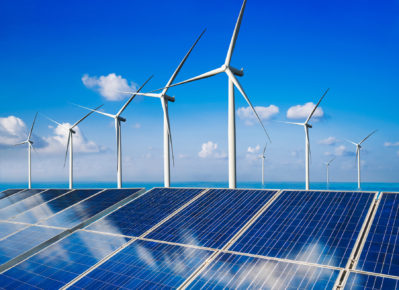Journey to Zero Emissions: Greenhouse Gases 101
In the face of the climate crisis, the growing importance of environmental, social and governance (ESG) initiatives, and evolving laws and regulations, most companies realize that their long-term success depends on starting the journey toward zero emissions.
But for any company, that road can be intimidating and complex. To build a roadmap that will successfully lead you to carbon neutrality — and eventually zero emissions — you must first understand the basics of greenhouse gases and the strategies you can use to combat those emissions.
In this blog post, the first in a three-part sustainability series, we will explore these foundational concepts, so you can better understand where your company currently stands and what steps can help you move toward a cleaner future.
Greenhouse Gas Emissions Defined
A company’s emissions are the greenhouse gases it releases as a result of business activities, including general facility operations, transportation and other processes.
Greenhouse gases are chemical compounds in the earth’s atmosphere. When sunlight hits the earth, some radiation is reflected back toward space. Greenhouse gases trap this heat and create a greenhouse effect, which results in global warming and climate change.
Carbon dioxide, which is created by burning fossil fuels, solid waste and trees, as well as some chemical reactions, makes up about 80% of greenhouse gases. Other greenhouse gases include:
- Methane: Methane comes from raising livestock, agricultural practices, the decay of solid waste, and the production and transportation of coal, natural gas and oil.
- Nitrous oxide: Nitrous oxide emissions are largely a result of farming practices with synthetic fertilizers and cattle ranching. They are also generated during the combustion of fossil fuels and the treatment of wastewater.
- Fluorinated gases: While these types of gases are typically emitted in smaller amounts than the previously mentioned gases, they are potent. Fluorinated gases are generated through a variety of household, commercial, and industrial processes and sources, including refrigerants, aerosol propellants, solvents and fire retardants.
Carbon dioxide is the most well-known and easiest greenhouse gas to manage with efficiency reductions or purchased credits. However, to achieve zero emissions, all greenhouse gas emissions must decline to zero, not just carbon dioxide. Moving toward zero emissions requires a strategic approach that often combines more than one emission-lowering approach.
How to Move Toward Zero Emissions
Once you understand the different types of greenhouse gases, the next step is to determine what actions your business can take to move toward zero emissions. There are several strategies you can combine and utilize on your journey to becoming emission-free.
1. Implement Efficiency Upgrades
One way to decrease emissions is to evaluate your business for potential energy efficiency projects. There are a few key places you can look to identify areas for improvement. You can analyze your energy bills for spikes or changes in consumption and consider what equipment in your facility may be outdated or inefficient. For example, you might identify an aging HVAC system, light bulbs that burn out quickly and frequently or inefficient machinery components.
Then, consider replacing those systems with energy efficient options. These solutions use a lower quantity of energy to provide the same amount of power as a non-energy-efficient alternative. By implementing these types of upgrades, you can decrease your greenhouse gas emissions and realize cost savings.
2. Supplement Fossil Fuel Usage
To decrease emissions, you may consider supplementing fossil fuel usage with renewable and/or emission-free energy.
Renewable energy comes from sources that the earth can naturally replenish over time, such as sunlight, water and wind. Renewable energy sources are often more cost-effective and less harmful to the environment than fossil fuels. Most renewable energy sources are also emission-free, which means they do not generate greenhouse gases. Nuclear energy is also emission-free but is not considered a renewable resource.
It is important to note that some renewable energy sources do emit greenhouse gases. Burning biomatter, for example, can release carbon dioxide. However, biomatter is created from plants, and because those plants captured carbon dioxide from the atmosphere while they were growing, the biomatter essentially becomes carbon-neutral.
3. Credit Remaining Emissions
Companies have options to reduce emissions by purchasing carbon offsets or procuring emission-free energy through the purchase of renewable energy certificates (RECs) or emission-free energy credits (EFECs).
RECs and EFECs represent the positive environmental attributes of one megawatt hour (MWh) of electricity generated by a renewable energy source or emission-free resource, respectively. Companies can purchase RECs and EFECs to account for and track renewable and emission-free electricity generation and use. This allows companies to more effectively substantiate electricity use claims, especially on a shared utility grid, where there is essentially no way to track where or how any particular portion of energy was generated.
Carbon offsets can be purchased to reduce or offset a company’s onsite greenhouse gas emissions. Carbon offsets fund projects that result in greenhouse gas reductions, such as forestry preservation, certain types of agriculture, water and waste management, and carbon sequestration. A renewable energy project may also be eligible to create carbon offsets if the project prevents a fossil-fuel-fired generator or group of generators from operating and creating carbon emissions. (Renewables projects may be eligible to create RECs or offsets but not both.) So, if a company buys offsets to match 100% of its greenhouse gas emissions, it can make the claim that it has achieved carbon neutrality (or “net-zero emissions”) in regard to its onsite operations. (Note: This is different from achieving zero emissions, in which a company isn’t just cancelling out the carbon it produces, but instead, it is not producing any carbon emissions at all.)
While the journey to zero emissions can be long and complex, it’s a worthwhile effort. For more information about creating a sustainability plan that will enable your company to reach its environmental goals, download our guide, “4 Steps to Documenting Your Sustainability Plan.” If you need additional help creating a sustainability roadmap for your company, our representatives can help you build a custom plan. Get in touch to learn more.
The next post of our sustainability series will break down the three scopes of emissions, which enable you to categorize and assess your current carbon footprint. In addition, we will explore a few key tactics to target each of those scopes.







